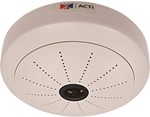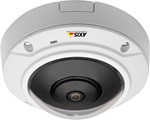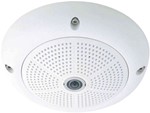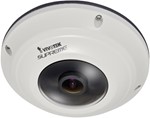360-Degree IP Camera Product Review | Table Of Contents
By The Business Solutions Network
 Testing By Andrew Wong, project engineer, American Integrated Security Group (AISG)
Testing By Andrew Wong, project engineer, American Integrated Security Group (AISG)
An integrator evaluates six 360-degree IP video surveillance cameras ideal for retail applications.
If you’re a VAR in the retail and restaurant space that passed up on video surveillance because it was too expensive and/or your customers were married to antiquated analog cameras, pay attention. There’s a class of high-definition IP cameras that can provide higher resolution/better picture quality than analog cameras, can be deployed in a way that one camera replaces four to six (or even more) old cameras, and gives merchants access to powerful analytics not only to prevent loss but also to help with marketing. I’m talking about 360-degree hemispheric/fisheye cameras.
Not familiar? Put most basically, these cameras for the most part look like smoke detectors, with a single fisheye lens in the center. Mounted to the ceiling in the center of a room, one camera can view and record a 360-degree area. With the aid of software, the sphere of video can be digitally de-warped on the fly to look like individual feeds from multiple cameras. Hence, one camera does the work of many analog cameras.
According to a Vivotek white paper, one camera mounted to a 10-foot-high ceiling is capable of covering a 65 ft. by 65 ft. room. That’s 4,200 square feet of coverage with a single camera. Imagine not just the cost savings of deploying cameras and cabling but also the lower administrative costs of a single camera. This class of camera is so unique and powerful, we wanted to compare the various models available in the market today while educating you on the capabilities.
For this review, we partnered with integrator American Integrated Security Group (AISG, also featured on page 24) to leverage the company’s video surveillance experience. To determine which cameras to test, we gathered intel on all the vendors that manufacture 360-degree cameras, ran it against a panel of experienced security integrators, and confirmed the major players by working with ScanSource’s physical security gurus.
In the end, we wound up with six cameras to test. Axis Communications, Mobotix, GeoVision, Vivotek, and Panasonic provided 360-degree fisheye lens cameras. ACTi provided a camera that uses two lenses to view 180-degrees forward and 180-degrees backward, achieving the 360-degree effect. To test these cameras, we used Wavestore VMS as our software platform due to the software’s ability to de-warp 360-degree camera video. Following are the results of our tests.
-- Click Here To Read The Full Side-By-Side Product Comparison Article --
Individual 360-Degree IP Camera Product Reviews
|
|
|
|
One part of our testing involved evaluating how much bandwidth these cameras used to achieve their image quality. In normal light situations, the ACTi KCM3911 came in second-highest at 1.8MB/sec. In low light tests, the ACTi camera needed just 500KB/second, which was about average when looking at all cameras tested. |
|
|
|
|
|
Many IP video cameras have followed the lead of cell phone and digital photography cameras by adding memory card slots. Indeed, all of the cameras we reviewed have a memory card slot. Additionally, many IP video cameras also have mini computers on board with integrated DVR and video management capabilities. The Axis M3007-PV has such capabilities. |
|
|
|
|
|
The Geovision FE420 is ONVIF compliant. According to Wong, “ONVIF [Open Network Video Interface Forum] is an open industry forum promoting and developing global standards for interfaces of IP-based physical security products,” he says. “Companies can design and test based on published standards, ensuring compatibility of devices and ultimately saving time and money. What used to take hours and sometimes two or three different software applications can now be accomplished with the simple push of a button, allowing the installer to auto-discover all of the cameras on the IP network.” |
|
|
|
|
|
A very important aspect of video surveillance is performing site surveys. These allow you to identify the exact needs of your customer and avoid embarrassing mistakes. One mistake you could make is installing a camera in a location that’s either too hot (remember, warm air rises) or too cold. The Mobotix camera can handle temperatures as low as -22 degrees. When it comes to heat, the best performer of all cameras tested is the Mobotix camera, capable of operating at 140 degrees. |
|
|
|
|
|
Generally speaking, IP cameras today can be powered using PoE (Power over Ethernet) or using good old fashioned DC/AC wiring. According to Andrew Wong, project engineer for AISG, using PoE cameras will reduce the cost and time for a project. “PoE will eliminate the need to hire an electrician to run conduit and create a power source for your devices,” he explains. “Additionally, PoE devices can easily be installed and relocated with a single Ethernet wire pull.” He adds that PoE deployments should include a UPS (uninterruptible power supply) connected to the PoE switch to ensure, in the event of an outage or surge, all devices are protected and kept running. The Panasonic WV-SW458 supports both PoE and traditional electrical wiring. |
|
|
|
|
|
Many IP video cameras have followed the lead of cell phone and digital photography cameras by adding memory card slots. Indeed, all of the cameras we reviewed have a memory card slot. Additionally, many IP video cameras also have mini computers on board with integrated DVR and video management capabilities. The Vivotek FE8172 has such functionality. |
|






